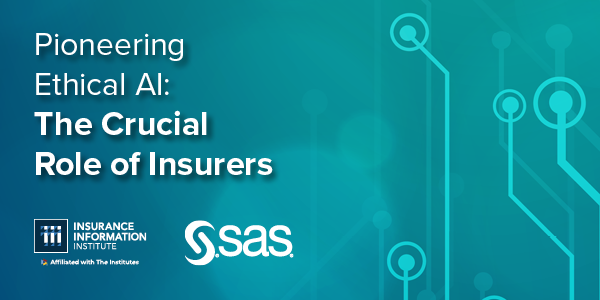AI democratization has gained dizzying momentum, with technology laypeople having easy access to incredibly powerful tools. As of October 2024, Microsoft Copilot had an estimated 28 million users.
AI and AI-adjacent tools have become ubiquitous in everyday life. For example, real estate apps embed climate risk tools into the interface (look closely at the accompanying video – you may see yours truly).
So, what does this mean for the insurance industry? It could be the answer to a terribly daunting problem on the horizon – the silver tsunami.
The industry is in a talent war. In the US, 400,000 workers are expected to retire by 2026. A survey by The Institutes shows 8 of 10 millennials have limited knowledge of the industry – and 44% do not find a career in insurance interesting.
Insurers will need to demonstrate the sexier side of the business by highlighting opportunities to work with leading-edge technology.
The AI insurance market is soaring
The global insurance analytics market is around $11.3 billion. Specifically, AI life cycle and AI software services are approximately 10% of that number – about the same as business intelligence software. For comparison, database management systems are around $3.6 billion and risk management applications are around $1.9 billion.
The difference is that the entire insurance market is only growing around 18% three-year CAGR while the AI market (including the subset of GenAI) is growing between 37% and 62%.
In recent months, we’ve seen enthusiasm with GenAI, ChatGPT and large language models (LLMs) decline sharply. That’s because we are coming out of the trough of what many know as the “Gartner Hype Cycle.”
The AI explosion that came with ChatGPT creates a polarizing debate with insurers (some are banning the technology while others are embracing it). But the value is clear.
McKinsey estimates that insurers will gain $50 billion to $70 billion of revenue from the impact of GenAI across business functions. They also report that “AI leaders” outpace “laggards” by two to six times on total shareholder returns, across every sector analyzed (including insurance).

Still not using AI? Time to scratch that itch.
We can quantify AI's perceived impact, and we know that insurance work will change as a result.
In his book, “The Economic Singularity,” author Calum Chace connects the concept of 15th-century Dutch workers throwing their wooden shoes (sabots) into textile looms, enraged that the technology would take their jobs. But in every historical instance (he continues), humanity has upskilled itself.
This reskilling started with the dawn of manufacturing and has continued to the fourth industrial revolution (or Industry 4.0): the integration of physical and digital worlds through AI and autonomous systems. With that integration, we must discuss the need for insurers to position themselves as AI-forward institutions to the next generation of insurance professionals.
The bionic workforce
Reports from Microsoft and LinkedIn found that 68% of people struggle with the pace and volume of work. About 46% are burned out, and 54% of early career employees’ decisions to work for one employer versus another would be influenced by access to AI.
AI enthusiasts continue to share “time savings” as a wonderful application for adding value. AI assistants like copilots not only save time. They also allow employees, such as underwriters, access to large data sets, market dynamics and new information – things that are not readily available through a cursory Google search.
Integrating AI with business processes – an example
Let’s imagine an underwriter reads a paper from the Institute of Catastrophic Loss Reduction (ICLR) examining the Lytton, British Columbia fire (June 30, 2021). In it, she learns that a structure’s “ignition zone” falls within 30 meters or around 98 feet (page 18).
Her enterprise recently integrated aerial imagery into her underwriting workbench to combat wildfires. The platform offers low- and no-code features, so writing a program to determine the distance from a structure to vegetation is accomplished in minutes.
With this knowledge, she asks Microsoft Copilot the following prompt about her territory: “Hello, Copilot. Please provide a list of all insured locations in Alberta, Canada within 99 feet of dense vegetation. Thank you, Copilot.”
Science fiction? Nope.
These computer vision, GenAI and machine learning technologies are all available, today (attend ITC Vegas just once, and you’ll see what I mean).
Armed with this new information, the underwriter could work with her distribution, loss control and community partners to address areas most prone to wildfire risk. This is the successful integration of AI with today’s business processes and represents the real “last mile” challenge for insurers.
AI assistant versus AI agent
As Neo discovers in Matrix Reloaded, the problem is choice. In the above example, the human has the agency to decide what action to take, while AI agents have autonomy to act to achieve predetermined goals.
Insurance is the business of making decisions. Decision intelligence is increasing in importance as insurers look to use data to drive more efficient decision-making while reducing costs and maintaining appropriate risk controls across every facet of the insurance equation – from quote to claim.

Decisions by AI – black box or transparent?
There’s a cross-section of AI agents that are “black box” (their operations are not visible or easily explainable). In some cases, insurers may choose to use these tools, but they will have to decide which tasks an AI black box can safely handle.
All models drift, black or white, and as the name implies, machines learn. As a result, agents’ capabilities change.
Employing an AI agent to underwrite policies or settle claims comes with risk. And some tasks should not be automated at all. In some geos, certain AI uses are forbidden, while others are not.
Take the EU. What if AI were used to manipulate policyholders into buying unnecessary coverage, or to launch fraud investigations based on social scoring? The EU AI Intelligence Act would place both in the “unacceptable risk” category.
The role of literacy, education and governance
AI literacy is invaluable and is even required by some regulations. But to realize effective, measurable and transparent outcomes, workers must be upskilled.
Organizations like PZU (a larger European insurer) – with clearly defined AI identities (such as established AI guidelines and guardrails) – provide fertile ground for insurance professionals to safely use algorithmic, autonomous and artificial intelligence technologies. At a minimum, having clear positions on AI and its use, along with a strong culture and educated staff, will protect insurers from noncompliance with AI regulations.
Learn about the deep value of AI governance – and the role insurers can play in ethical AI.
The bottom line: People will never go out of business
Insurance is a noble profession. AI unlocks the industry’s potential to shift into “warp speed.” It does not, however, replace the talented men and women we have underwriting policies, settling claims or helping customers with their needs.
Keep in mind that people depend on AI markets for their livelihood. Consider the UK, where 524 UK-based AI firms employ around 12,000 people. This market is poised to grow sixfold over the next decade, unlocking more than £6.5 billion of value.
With this explosion are calls for AI safety. Both the UK and Singapore have responded by signing AI safety agreements, further signaling the need for international cooperation in the use of these powerful tools.
Humans are critical to ensuring safety. As a starting point, all insurers should take these next, immediate steps:
- Establish clear guardrails on the proper use of AI.
- Integrate a Code of Data Ethics into your employee handbook and other governing documents.
- Assign AI authority grants to employees for using AI tools, including the power to halt the use of AI systems and alert executive leadership when critical issues arise.
You wouldn’t allow a copilot you can’t trust in the cockpit to fly the plane. The same applies to AI for your business.
Learn how and why to invest in trustworthy AI
Ready to grow premiums, reduce costs and create efficiencies? It’s time to invest in artificial intelligence software, educate staff on how to use it responsibly and stretch your conventional thinking on all insurance processes.
Download a paper to learn more about the critical role insurers play in ethical AI



